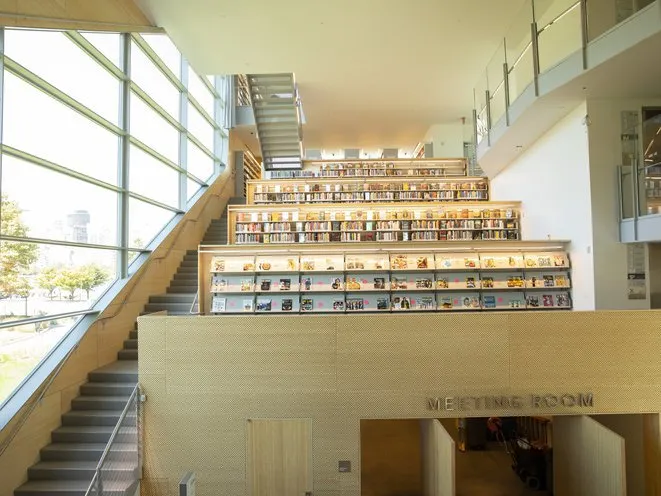
The $41 Million Hunter’s Point Library Is Not Accessible
The Gothamist reports that the new Hunters Point Library in Queens has three floors that are only accessible by stairs. The notoriously troubled $41 million project, begun in 2010, concluded with a September 12th opening. Its design has previously been celebrated as “thoughtfully designed, thoroughly modern civic structure that will be an inspiring place for learning in the 21st century” and has won design awards. However, Jackson Heights photographer Joe Bachner, himself possessed of bad knees, noted last week that three fiction floors are inaccessible except by stairway. This essentially precludes access by chair or for people with mobility problems.
 An initial statement from the library justified this decision by claiming that librarians would be able to retrieve books for patrons. However, this failed to address the possibility of disabled librarians being unable to reach these inaccessible stacks, too.
The large building is partially served by a single elevator.
An initial statement from the library justified this decision by claiming that librarians would be able to retrieve books for patrons. However, this failed to address the possibility of disabled librarians being unable to reach these inaccessible stacks, too.
The large building is partially served by a single elevator.
 An initial statement from the library justified this decision by claiming that librarians would be able to retrieve books for patrons. However, this failed to address the possibility of disabled librarians being unable to reach these inaccessible stacks, too.
The large building is partially served by a single elevator.
An initial statement from the library justified this decision by claiming that librarians would be able to retrieve books for patrons. However, this failed to address the possibility of disabled librarians being unable to reach these inaccessible stacks, too.
The large building is partially served by a single elevator.
The Library’s Response
Since this story broke on October 4th, the library has announced that it’s moving the contents of those three floors into accessible areas. However, this does not change the fact that significant areas of this library are essentially unusable. In an industry where book storage space is precious, the oversight on the parts of the library planners is doubly egregious. It is hard to imagine spending close to two decades on this project without noticing the inaccessible floors.“Our staff has been and will continue to retrieve books for customers, and we are going to offer devices that will allow customers to browse the materials available in those areas.” Orrrrr you could have just made the library accessiblehttps://t.co/FkBpBYBWAC — Kendra “Gloom is My Beat” Pierre-Louis (@KendraWrites) October 4, 2019This architectural decision is particularly puzzling in light of the fact that older patrons represent an important demographic for libraries. Paper-printed books are still central to the library experience of many senior citizens. The normal health concerns of aging bodies also preclude climbing entire banks of staircases just to browse fiction shelves. According to Pew, two thirds of visitors still use the public library primarily to borrow books. Planning to place books inaccessibly implies that both disabled patrons and the printed word are secondhand concerns to this branch, falling after impressive architectural design in importance. It also implies a lack of consultation with both ADA experts and librarians. In a $41 million budget, it is amazing that professional architects, staff, and administrators overlooked this step.
Visual effect vs. practicality
The building is complete, the budget has been spent, and the library is undeniably a striking architectural marvel. However, the question of why the library had to be an architectural marvel, and why this was so much more important than accessibility, remains to be answered. At its root, the public library is a practical space. While it’s important that it should be visually welcoming and pleasant, its first job is to provide services. There are libraries that live in town hall basements and still provide adequate services to their communities. They accomplish this by placing patron service first and prioritizing community needs, including accessibility. That clearly didn’t happen in the case of Hunters Point.I’ve worked in libraries where powered furniture was bought for areas where outlets couldn’t be installed, & where the moveable furniture was too heavy to move, but this is way beyond any of that. How did the architects, board and/or staff let this happen?https://t.co/FPjulxfbJb — Callan Bignoli ✨ (@eminencefont) October 5, 2019Any librarian who has worked five minutes on a service desk knows that disabled patrons are common visitors. Patrons with canes, crutches, and wheelchairs all rely on elevator access. Groups of mentally disabled people, sometimes from training programs, adult daycares, or group homes, may also avoid stairs. This may be due to either physical limitations or a desire to keep everybody together. Large staircases even preclude moms with strollers from getting to certain areas of the library without the use of elevators.









